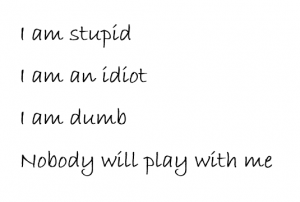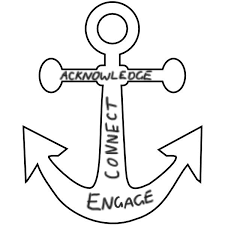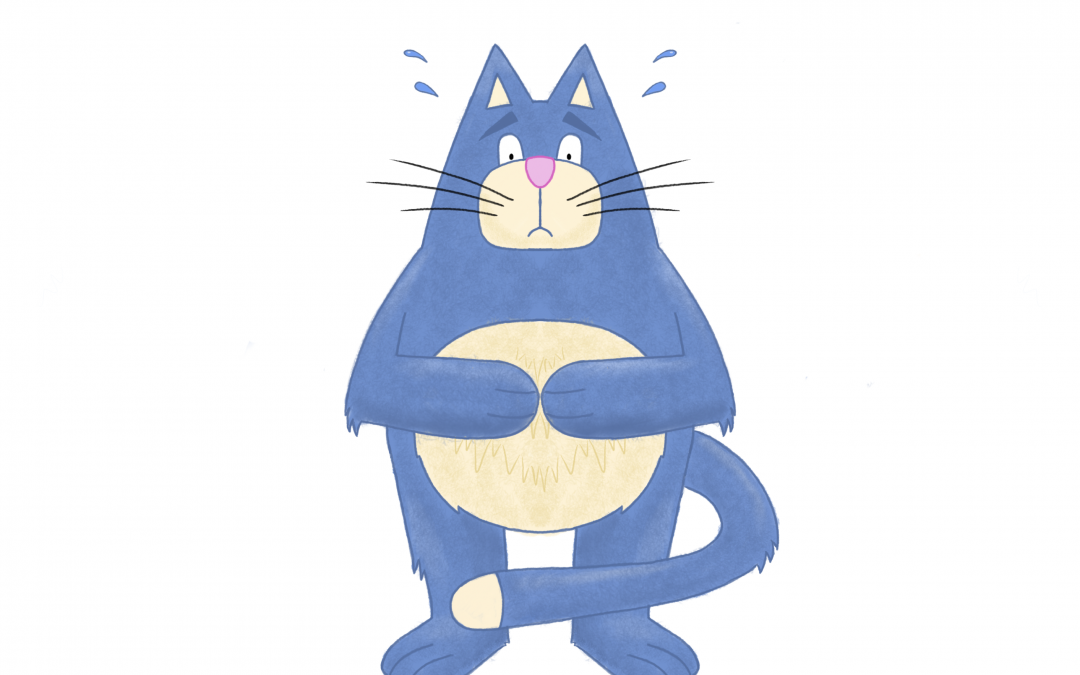Anxiety in Children
This article is a brief overview of the work that I do with children who experience feelings of anxiety.
Feelings of anxiety are a common concern for my younger clients. What follows are strategies to help assist in; noticing unhelpful thoughts and emotions, how to unhook from them, and ways of changing how we respond to unwanted thoughts and emotions.
When parents contact me and share their concerns over their child’s anxiety I usually respond with, ‘I wonder what stories their brain is telling them’.
The Negative Brain
Brains are generally negative. The grown-up word is ‘Negativity-bias’. For young children I tell them about ANTS, which stands for Automatic Negative Thoughts. For older children, we talk about how the brain is Negative, Quick and Lazy. This is a dangerous combination, but it is all part of our brains trying to keep us safe like an over-zealous, hypervigilant, super-nanny.
If I Think it, Then it Must be True
It is also helpful to know what our brain thinks about its own thinking:
- If the brain thinks it, then it thinks it must be true,
- The longer the brain thinks something, the truer it seems,
- We often feel it before we think it (we are feeling creatures who think),
- The brain doesn’t like discomfort and will seek to reduce discomfort in ways which usually make it worse,
- The brain will tell us that we won’t be able to cope.
The Regular Brain Stories
Our brain has some regular stories which it uses over and over again. It is all part of being negative, quick, and lazy.
- The Worst-Case Scenario Story (WCS): Our brain will catastrophise about imagined future events where it plays out the worst thing that could happen.
- The What-If Story: Closely related to the WCS, the What-If story will have us imagining bad things in the future where, what-if this happens, or what-if that happens. The What-if story, also runs into the past. What-if I had just done this or that, or What-if I had tried harder etc. If you try to argue with the What-If story, you will not win as the brain can always come back with ‘but what if’. This story also robs us of the present moment with our brain time-travelling in either direction.
- The Not-Good-Enough Story (NGE): This story shows up when we make a mistake, and when we are worried that we won’t do well at school. It shows up when we compare ourselves, judge ourselves, and we tell ourselves that we are not good enough.

The Unhelpful List
What we think isn’t actually the problem. The problem is when we get hooked by these stories. The thought takes hold and one thought leads to another and we spiral. I often ask children to list some of their brain stories. Children will write sentences about being dumb or stupid or an idiot. They will acknowledge self-hatred and may throw in a swear word or two. Out of context, these lists look bad, but they are also extremely normal. Children have also expressed concern over what-if mum and dad don’t like me, what if I let my parents down. Our brains really do not do us any favours when it comes to self-talk. I don’t argue with their lists, but I do ask if this list is helpful or unhelpful. We conclude that it is Unhelpful.

Normalise and Validate
It is important that our children know that they will not be judged for the what their brains may tell them. When I was a kid and I did something wrong, my mother would berate me and say, ‘What on earth were you thinking?’ Double shame: not only was I feeling bad for doing something wrong, but I also felt bad for thinking something wrong.
When I see their lists of thoughts I respond with, ‘You too? My brain says stuff like that’. I Normalise the thoughts. When I am in the counselling room, I often ask Mum or Dad if their brain says stuff like that as well. Children are genuinely surprised to learn that grown-up brains also say unhelpful things. I then Validate; what happens when these thoughts hook you? How do you end up feeling? What do you end up doing? This sounds horrible and unpleasant. Then we call it for what it is: unhelpful, and we label the list as unhelpful.
Unhooking and Anchoring
To unhook from the list, I ask them to choose one sentence from their list and to say it with, ‘I notice I’m having the thought……’ They usually respond by saying that this simple sentence manages to shift the thought in some way – like it is less-than. We can also give the thoughts a name; the Not-good-enough-story, the scary-monster-story. I notice that I’m thinking of the- scary-monster-story. Next we notice the present; we notice the room, notice our bodies, notice what we can see, and hear, we have a stretch, we take some big breaths. We notice the moment we are in and recite, ‘I am here, and I am safe.’ We talk about things that we like to do, drawing, craft, playing a game – this is to help us engage in something meaningful.
There are many ways to unhook from unhelpful thinking. Acknowledging the thoughts and feelings is the first step.

You Can’t Argue with the Future
Anxieties and fears are fuelled by an imagined future. The problem is, when we, the grown-ups, try to reason with our anxious children about their fears, we are arguing with the What-if story. Arguments with the What-if story can never win because the brain will always come back with, ‘but what-if it does happen.’ You can’t argue with an imagined future.
Anxiety and Fear Distract from Logic
Fear and Anxiety are unpleasant emotions. They serve the purpose of warning us of potential dangers or threats. The problem with these unpleasant emotions, is that we get caught up in the experience of them. The brain doesn’t like the unpleasant and will seek ways to avoid it. Unfortunately, it often makes things worse for itself. As a result, we become anxious because we are anxious, or more fearful because we are feeling fear. The adage, fear breeds fear is very real.
Ironically, the brain doesn’t want to be proven wrong either and will seek to justify its unpleasant reactions. Logic becomes irrelevant. In a state of heightened arousal, with our thoughts spinning in our emotional mind, we fail to question the validity of our fears.
Thunder Can’t Hurt you
Is this something to be frightened of?
I was in a Foundation classroom recently when there was a thunderstorm. As the thunder clapped, I watched several students immediately put their hands on their ears and pull their legs up into a frightened tuck. I acknowledge that thunder is a loud noise that isn’t very pleasant, and can sound scary, but thunder cannot hurt us. I then gave them the instruction that for the next thunderclap we would say, ‘Loud noise, not dangerous, we’re safe’. I don’t know what I was expecting to happen, but the next time the thunder clapped, several kids said out loud, ‘loud noise, not dangerous, we’re safe’. They did this again and again for as along as the storm lasted. I was so impressed with how these young children had turned their automatic fear response into a logical and reasonable statement. It also made me wonder if I was the first person to tell them that the sound of thunder could not actually hurt them.

Future Fears
Anxiety in children can be attributed to a variety of reasons. In many cases, the child can tell you what they are afraid of; I am afraid that I will be taken, I am afraid that a bad person will come into my room, I am afraid of monsters, I am afraid that something bad will happen to Mum and Dad, I am afraid that something bad will happen to me. For some, they wake at night, and the What-if-worst-case brain story starts up. After that, they hear every noise and every bump, and their imagination fills in the rest.
In all of these cases, their fear is fuelled by an imagined future. This imagined future distracts them from their past experiences of success and their safe present moment; Monsters haven’t ever come out of the cupboard, they are safe in their homes with their family, Mum and Dad are ok.
Give the Thought a Title
We need to teach our children how to notice their thoughts. Like I did with the list activity. ‘I notice the scary-story-is-showing up again’, the ‘something-bad-will-happen-to-me-story’. This can help to reduce all consuming thoughts down to manageable, categorised, collections of thought stories.
Be Present and State the Safety
Next, we notice the present moment we are in. I can see my bedroom, and I can feel my cosy bed around me, the weight of my doona upon me. My toys are in the room, the night light is casting soft light around my room. I am safe. My family are here, and I am safe. This is deliberate self-talk. We are re-training how we think.
Hypothesis Testing
In the book, ‘When perfect isn’t good enough’, the authors provide the strategy of hypothesis testing. This is where, instead of being tormented by that worrying mind we put it to the test. We deliberately set out to test the fear by using our experience. ‘Every night you go to bed and in the morning you are safe’: Let’s hypothesise that tomorrow morning when you wake up, you will be safe. ‘Everyday mum drops you off at school, and every afternoon she (or another known adult), is there to pick you up: Let’s hypothesise that tomorrow when you get dropped off at school, Mum will be safe, and you will see her after school’.
Hypothesis testing has had positive results with my clients. Instead of being focused on their futuristic fearsome What-if-story, they become aware of consistent positive outcomes. An outcome which, up until now, has failed to be noticed.
These are a few strategies, there are many more.
An Internal Problem needs An Internal Solution
Fear and Anxiety is an internal problem. It is connected to the story that our mind is telling us; allow the brain to have its say, but don’t hook into it. We can choose how we respond to the vast array of brain-stories. Worrying and obsessive thoughts are a primary cause for poor mental health. When I have shown clients how to notice their thoughts and emotions, I see them take control of their lives. They begin to connect with their values and start making decisions that serve to help them move toward the person they desire to be.
We can help our children move toward the person they would like to be. Help remind them of times when they have enjoyed themselves. What was that like? What did you do? How did you feel? Help create connections to their strengths. Remind them of successes in the past, what they have managed to do despite fears. In this way, they become their own resource for a better way of knowing themselves.
Martin M Antony and Richard P. Swinson (1998) ‘When perfect isn’t good enough’
Related to this topic are the following articles:
About Gwen
Gwen is a school teacher, counsellor, author and presenter. Gwen’s counselling practice caters particularly for children, adolescents, teachers and parents, as well as generalised counselling. She works with individuals in relation to mental health and wellbeing. Gwen is the author of Bully Resilience: Changing the Game. See www.equipcc.com.au for more information.


Recent Comments